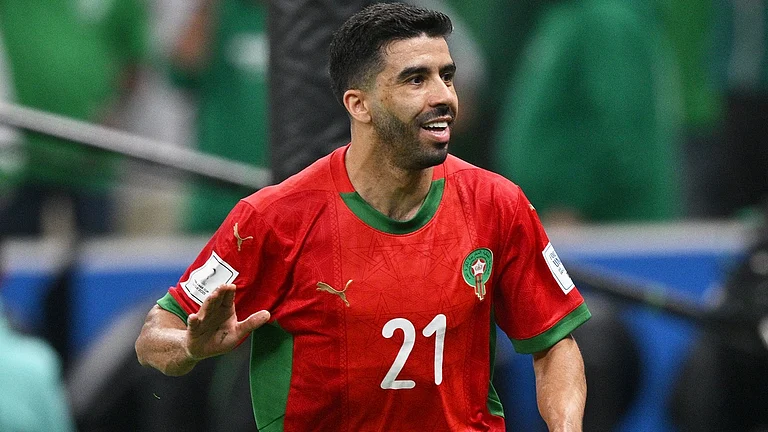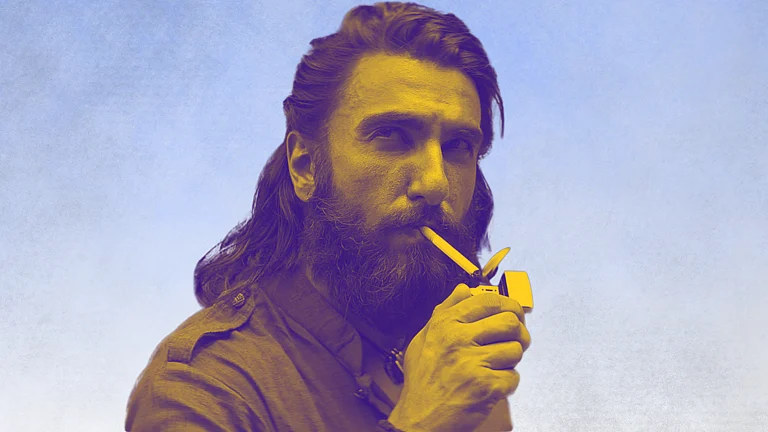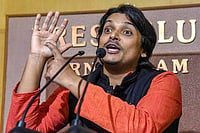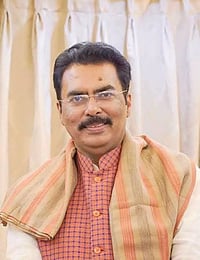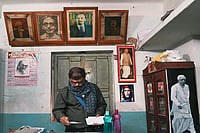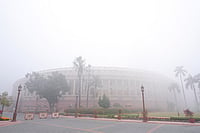Just two days after my arrival in Lahore, I was hurtling along the Lahore-Islamabad motorway at 5 am with my friend Rasheeda. Our destination was Bhera, the ancestral town of all the Sahnis, or rather the Khukrain, which includes nine castes: Sahni, Sethi, Anand, Suri, Kohli, Bhasin, Chaddha, Sabharwal and Chandhok.
For our post-Partition generation, Khukrain and Bherochis (those from Bhera) were unusual-sounding words that occasionally cropped up in conversations of the older generation, including my father Bhisham Sahni and his brother, Balraj ji (the actor Balraj Sahni).
Signboards of vaguely familiar places flitted past us: Lala Musa, Gujranwala, Chakwaal. They held no associations for me. And Bhera? What did I know of this town? I had heard that it once was a flourishing trading centre on the Jhelum. Some Bherochis claim the battle between Porus and Sikander was fought near Bhera and that Porus was a Khukrain Sabharwal. A few others are convinced that Alexander was so impressed by the valour of the Bherochis that he returned to Greece with five brave Bherochis, whose successors still live there.
Chetan Anand, the film director, went even further. My father recalls how he always boasted about his profile: "See, this is the classical Greek profile". We Bherochis are Greeks! Some others unequivocally state that the Khukrain originate from Khorasan. A more recent encounter with Bhera was through my father's historical novel, Mayyadas ki Madi, set in Bhera: the havelis, the Diwans and the railway line that ended in this town. On this particular journey I wasn't concerned with sifting facts from fiction for I had no idea of the borderline. All I knew was we were heading for my father's ancestral town which was, as my Lahori friends had assured me, a mere two-hour drive from Lahore.
A board on a red-brick structure announced 'Bhera Restaurant' although there was no sign of any habitation on either side of the highway. The car sped on. The landscape changed. Low hills arose in the horizon. We must be approaching it, I thought. But we were soon told that we had overshot our destination and had to proceed back to where the restaurant was and take a detour from there.
Our journey for the next three hours was along a kutcha road. And pretty soon I was certain the Partition days must have been an exception in Bhera's history. Nobody could possibly have either visited or exited from Bhera since Alexander's time. Not along this road, at any rate. I understood why some Bherochis insist the actual name is Be-rah (without a road). Another plunge into a pothole rearranged my insides and cleared my head. I had another revelation. None of my Lahori friends had the foggiest idea about the whereabouts of Bhera! Their knowledge was confined to the restaurant they regularly zoomed past on their way to Islamabad.
We finally reached Bhera after a gruelling five-hour journey. Meanwhile, Rasheeda was unsuccessfully trying to discover the location of the Sahni Mohalla which was supposed to have existed. We took a side lane that led to an open area surrounded by two and three-storied havelis with protruding balconies-all with intricate woodcarvings. The houses stood amidst the rubble of solitary walls. My father mentioned abandoned homes where only the doors, with locks hanging, remained. Door after door after door-and all with big locks. No walls, no roofs, just rubble behind them. Had he referred to the time when the Jhelum changed its course and the town went to seed, gradually losing its importance as a trade centre? I was now beginning to doubt the existence of a Sahni Mohalla. It was then the miracle occurred.
"You mean Sahniyan da Mohalla?" asked a man who had materialised out of nowhere. "I'll show you." We could barely keep pace with this person who strode confidently through the maze of narrow lanes. Finally he stopped and, with his stick, pointed towards a house on the crossroads.
"There, Sahniyan da Mohalla begins from that house onwards." With these words he disappeared just as miraculously as he had appeared.
A partly broken-down double-storeyed house peered over the wall. I was led into a courtyard where four women of different age groups were busy with their chores. When they discovered I was a Sahni from India, they engulfed me with their warmth and love. "Please sit in the shade," said one. "Would you like some milk or lassi?" asked another.
I waited for a brief pause to slip in my question. "Do you still say aasaan-jaasaan?" The reply: "Of course. That is how we Bherochis are recognised wherever we go. We have only to open our mouths to give ourselves away."
We all laughed. Then, with a perplexed look on her face, the youngest of the four turned to me and asked, "Do people in Delhi also speak like us?"
"If they are Bherochis, yes. And there too the other Punjabis immediately recognise who they have in their midst," I said.
None of the women recalled the past for they belonged to the post-Partition generation. They had bought this house about 30 years ago. It had been a beautiful house, but the recent flood had destroyed a part of it. I looked around and couldn't rein in my flights of fancy. Could this be the house my grandfather grew up in? Was that the balcony from where my father played pranks on the passers-by on the road?
This locality is still called Sahniyan da Mohalla as is the adjacent, Sethiyan da. The women couldn't enlighten me on the Sahni families, but they sent for someone. Mir Mohammad was a gaunt old man in a lungi. Despite his grey beard and walking stick, his shoulders were not drooping as he walked up to us with a broad smile and twinkling eyes. He had barely sat down on the charpai in front of me before he let loose a volley of questions.
"You've come from India? Really? I don't believe it! From Delhi? And you are a Bherochi you say? A Sahni? What's your father's name? And your grandfather's?" And then Mir Mohammad reeled off a string of names of people he recalled from the Sahni clan: Mohan Lal Sahni, Diwan Ganpath, Diwan Jaigopal, then Pal and Jiya Sahni. None of the names rang a bell. As for me, I couldn't go beyond my grandfather's name. The old man tried to console me. "Numerous families had moved to Rawalpindi," he said. "Did you know the Sahni clan was the largest and richest one in Bhera? There were a thousand houses in the Sahniyan da Mohalla."
A thousand houses! All Sahni, and all related to each other! There we were in India, scattered in different parts of the country, rarely meeting one another, and here were a thousand houses! I imagined children growing up with hundreds of cousins, uncles and aunts. Then there must have been the countless relatives in the neighbouring mohallas of the Anand and the Sethi families. Didn't all the Khukrains intermarry? "Many people from the Sahni families went abroad to study," Mir Mohammad continued. Perhaps it was another of those Bherochi jokes, but it was said the British distinguished three types of Indians who went there to study: the Hindus, the Muslims and the Sahnis.
"It could be because the British had opened a school in Bhera? Did you know that an angrez was invited for the mahoorat of this house?" And Mir Mohammad proceeded to relate the story.
"This was the grandest house in the Sahniyan da Mohalla. For the mahoorat, the owners bought bales and bales of red fabric which they spread all the way from the railway station to the house. They didn't want their chief guest to soil his shoes on our kutcha road. So, just imagine, this angrez stepped off the train and straight on to the red cloth. You should have seen how pleased he was with the reception! He left in a very good mood and even praised the house."
Mir Mohammad laboured in the fields of Malik Suraj Kaul for a salary of nine rupees. And again he amazed me with his memory for names. He recalled every member of the family: the sons-Jagmohan, Manmohan, Susheel and Minnoo; the daughters: Phallaan and Kamla Rani. All of a sudden, the old man broke off and turned to me. "Meeting you has brought back all the Hindus of Bhera before my eyes."
He was silent, his head bent. Then he picked up his thread of reminiscences. The family he worked for had adopted him. Mir Mohammed affectionately recalled his Hindu teacher. "But I will never forgive them for one thing. Two months before Partition the Suraj Kaul family went to Murree. They never returned. I couldn't so much as hug them before their departure." Tears welled up in his eyes. "Please try and locate them. I have failed. Someone said that they are in Ghaziabad."
After another pause, he continued, "Life's never been the same since the Hindus left. We always used to celebrate each other's festivals. There was a sense of camaraderie amongst all the Bherochis, regardless of whether they were Hindus or Muslims. I remember how my father once took me to a mela. What is the name of that festival when giants are constructed and then burnt?"
"Dussehra."
"Yes, yes, Dussehra. See, I've even begun to forget the names. We went up to the halwai's stall. The halwai, a good friend of my father's, gave me a stern look and said, 'I don't give mithai to Mussalman children.'
'Which Mussalman kid do you see out here? This fellow?' my father retorted. 'Are you referring to him? He is no Mussalman. His name is Ashok.'
'Oh, is that so? In that case there's no problem,' and with a wink and a grin the shopkeeper handed me a fistful of jalebis. My father and the halwai were laughing as they watched me gobble up the jalebis."
Once again Mir Mohammed's eyes brimmed with unshed tears. "We used to laugh and joke with each other. Together we celebrated each birth and together mourned every death." Mir Mohammed accompanied us on a walking tour of the Sahniyan da Mohalla. The railway station was just beyond the town wall, on the other side of the mohalla. Like many of the British-made railway stations, this one also seemed frozen in time. A train had just left. Men were carrying out crates of merchandise. I wandered to the end of the platform and sat down on a deserted bench. Not far from it was the yellow board with its black lettering in bold letters: Bhera. It was supposed to have been the last town along the railway line. The old rail tracks were overgrown with grass. Were they the ones on which the British officer's train arrived?
I looked around in search of the hillock from where the Bherochis watched the approaching trains. The landscape was flat-no sign of even a mound. Yet another of my father's fantasies had floated and merged with my Bhera experiences. But the station and the platform were a reality, weren't they? I was overpowered by conflicting emotions-a sense of belonging and a sense of loss. Happiness intermingled with nostalgia and grief. I sat alone on the bench, crying.
When I returned to Delhi, my father told me that apart from a month during his elder sister's wedding, he had never lived in Bhera for any length of time. My cousin hurled the choicest abuses when she heard of my trip. Why hadn't I told her? Why hadn't I re-read my uncle's travelogue to Pakistan? She had photographs of our house, which my uncle had visited in 1962. Moreover, he had met a cousin in Sargodha.
I have to return to Bhera. But before that, I must locate the family of Malik Suraj Kaul.
(By arrangement with Friday Corporation)
(Kalpana Sahni is a professor of Russian literature at jnu, New Delhi. She is the daughter of Bhisham Sahni and niece of Balraj Sahni.)







